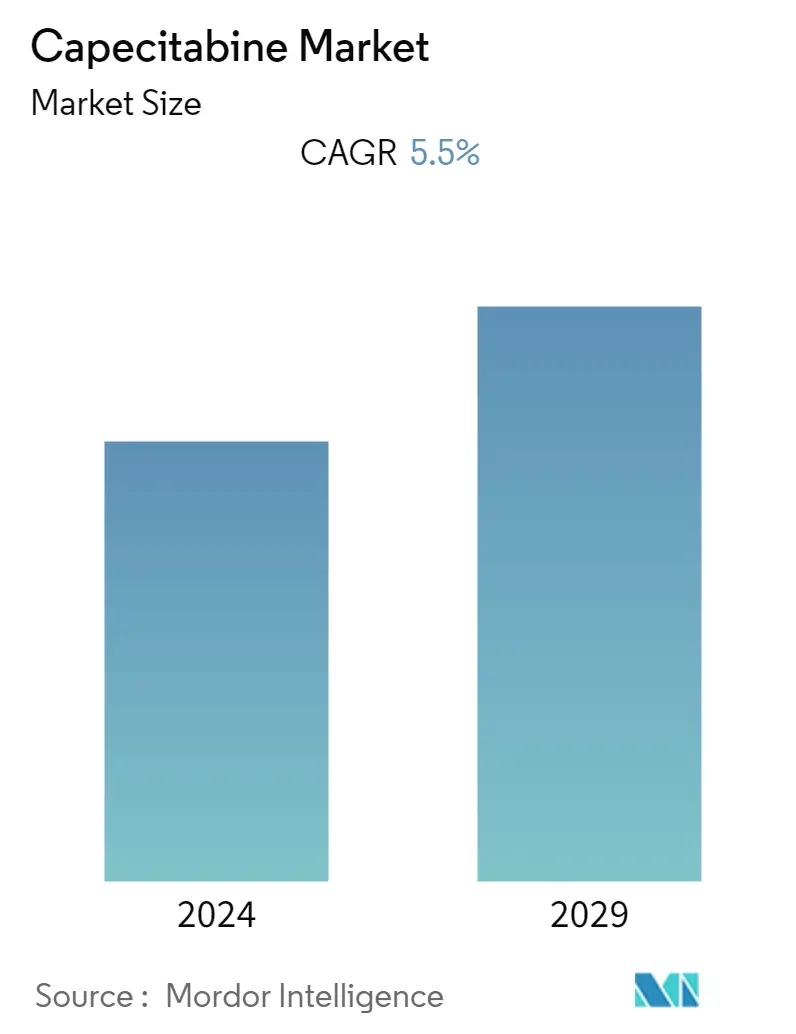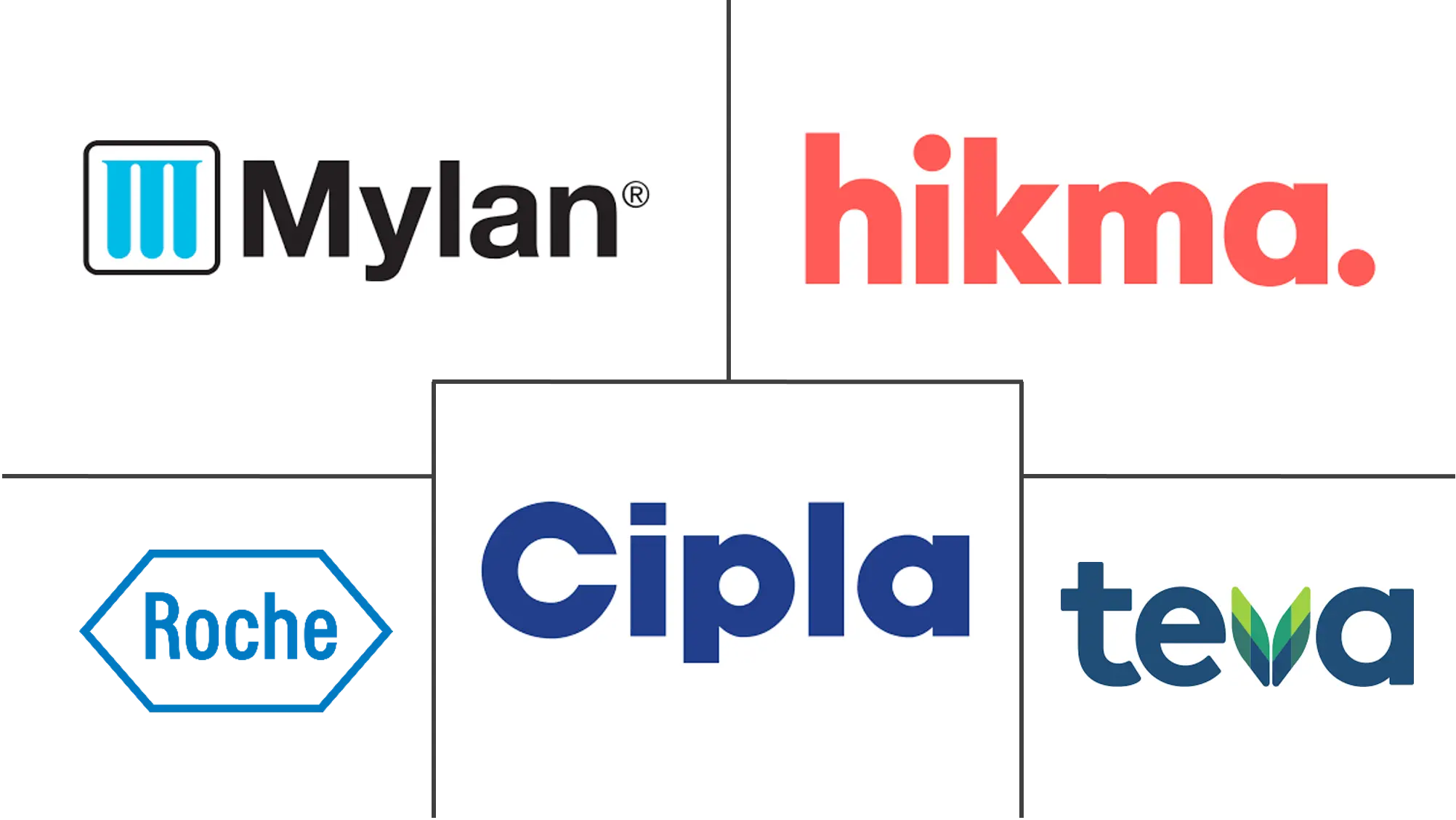Market Size of Capecitabine Industry

| Study Period | 2019 - 2029 |
| Base Year For Estimation | 2023 |
| Forecast Data Period | 2024 - 2029 |
| CAGR | 5.50 % |
| Fastest Growing Market | Asia Pacific |
| Largest Market | North America |
Major Players
*Disclaimer: Major Players sorted in no particular order |
Capecitabine Market Analysis
The Capecitabine market studied was anticipated to grow with a CAGR of 5.5% during the forecast period owing to the rising demand for target drug therapy to decrease the possible side effects without affecting normal cells. Increased demand for the capecitabine can be attributed to their antimetabolite activity that specifically works by interfering with DNA synthesis minimizing the severe adverse effects. Also, the growing global burden of patients diagnosed with cancer and tumors is likely to drive the market. As per the World Health Organization report, cancer is a leading cause of death worldwide and estimated that nearly 9.6 million deaths in 2018. Also, it is estimated that 627,000 women died from breast cancer accounting for about 15% of all cancer deaths among women across the globe. Also, a steep rise in healthcare expenditure, ongoing R&D activities in cancer treatment are likely to provide new opportunities for the market. Furthermore, growing awareness programs by governments and private organizations such as Cancer Care, Cancer Research UK, and Cancer Suraksha Scheme are anticipated to propel the global capecitabine market growth over the course of the period.
Capecitabine Industry Segmentation
Capecitabine is a nucleoside metabolic inhibitor that acts as a prodrug. The molecule gets converted to fluorouracil and inhibits DNA synthesis, thereby reduces the progression of cancer cells. It is administered orally and approved for the treatment of various cancers metastatic colorectal cancer, breast cancer, and others.
| Indication | |
| Colorectal Cancer | |
| Breast Cancer | |
| Others |
| Distribution Channel | |
| Hospitals | |
| Clinical Laboratories | |
| Others |
| Geography | ||||||||
| ||||||||
| ||||||||
| ||||||||
| ||||||||
|
Capecitabine Market Size Summary
The capecitabine market is poised for significant growth, driven by the increasing demand for targeted drug therapies that minimize side effects by specifically targeting cancer cells. This growth is further supported by the rising global incidence of cancer, which remains a leading cause of mortality worldwide. The market is benefiting from the drug's antimetabolite properties, which interfere with DNA synthesis, thereby reducing severe adverse effects. Additionally, the market is expected to expand due to heightened healthcare expenditure and ongoing research and development in cancer treatments. Awareness programs by governmental and private organizations are also contributing to the market's expansion, with the breast cancer sub-segment anticipated to hold a substantial market share due to the drug's proven efficacy and convenience in oral dosage form.
North America is projected to lead the capecitabine market throughout the forecast period, largely due to the high prevalence of various cancers, such as colorectal and colon cancer, in the region. Factors like physical inactivity, obesity, and a sedentary lifestyle contribute to the rising cancer incidences, while an aging population, particularly the baby boomer generation, further drives market growth. The presence of key industry players conducting clinical trials in the region is expected to enhance revenue. The market is moderately competitive, with major players employing strategies like product acquisitions and the launch of generic products to strengthen their positions. Notable companies in the market include Cipla Inc., Teva Pharmaceuticals USA Inc., and F. Hoffmann-La Roche AG, among others.
Capecitabine Market Size - Table of Contents
-
1. MARKET DYNAMICS
-
1.1 Market Overview
-
1.2 Market Drivers
-
1.2.1 Rising Government Initiatives to Control Growing Global Cancer Burden
-
1.2.2 Increasing Incidence of Cancers Around the World
-
-
1.3 Market Restraints
-
1.3.1 Highly Expensive Products and Treatment
-
1.3.2 Rising Adoption of Substitutes like Raltitrexed, Irinotecan and Leucovorin for Adjuvant Therapy
-
-
1.4 Porter's Five Force Analysis
-
1.4.1 Threat of New Entrants
-
1.4.2 Bargaining Power of Buyers/Consumers
-
1.4.3 Bargaining Power of Suppliers
-
1.4.4 Threat of Substitute Products
-
1.4.5 Intensity of Competitive Rivalry
-
-
-
2. MARKET SEGMENTATION
-
2.1 Indication
-
2.1.1 Colorectal Cancer
-
2.1.2 Breast Cancer
-
2.1.3 Others
-
-
2.2 Distribution Channel
-
2.2.1 Hospitals
-
2.2.2 Clinical Laboratories
-
2.2.3 Others
-
-
2.3 Geography
-
2.3.1 North America
-
2.3.1.1 United States
-
2.3.1.2 Canada
-
2.3.1.3 Mexico
-
-
2.3.2 Europe
-
2.3.2.1 Germany
-
2.3.2.2 United Kingdom
-
2.3.2.3 France
-
2.3.2.4 Italy
-
2.3.2.5 Spain
-
2.3.2.6 Rest of Europe
-
-
2.3.3 Asia-Pacific
-
2.3.3.1 China
-
2.3.3.2 Japan
-
2.3.3.3 India
-
2.3.3.4 Australia
-
2.3.3.5 South Korea
-
2.3.3.6 Rest of Asia-Pacific
-
-
2.3.4 Middle-East and Africa
-
2.3.4.1 GCC
-
2.3.4.2 South Africa
-
2.3.4.3 Rest of Middle-East and Africa
-
-
2.3.5 South America
-
2.3.5.1 Brazil
-
2.3.5.2 Argentina
-
2.3.5.3 Rest of South America
-
-
-
Capecitabine Market Size FAQs
What is the current Capecitabine Market size?
The Capecitabine Market is projected to register a CAGR of 5.5% during the forecast period (2024-2029)
Who are the key players in Capecitabine Market?
Teva Pharmaceuticals, Inc, F. Hoffmann-La Roche AG (Genentech, Inc.), Mylan N.V., Hikma Pharmaceuticals PLC and Cipla Inc. are the major companies operating in the Capecitabine Market.

